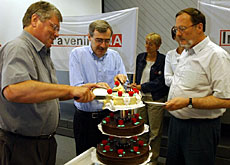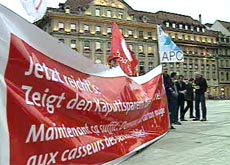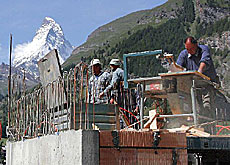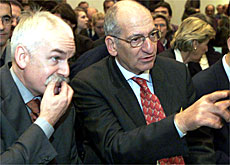Unions close ranks over new working conditions

Four trade unions representing around one million workers are set to join forces on Saturday in the biggest merger in the history of Switzerland’s labour movement.
Union leaders say the move is in response to economic changes since the mid-1990s, which have placed greater demands on workers.
The new Unia trade union, which will be founded at a congress in Basel, brings together four unions representing the construction and engineering industries as well as employees in the retail and catering sectors.
“In the past employees who changed jobs often had to join another union,” said Vasco Pedrina, co-president-designate of the new union. “Unia allows them to be a member of the same union all their lives.”
One of the main focuses of the new organisation will be the service sector where unions say employees face weaker collective contracts.
Counterweight
Unia sees itself as a counterbalance to the uncontrolled market forces and says it wants to be a major player on the political stage – a claim acknowledged by its opponents.
“Unia can be active across the economic sectors and its voice will no doubt be heard,” said Peter Hasler, president of Switzerland’s Employers’ Association.
The creation of Unia is the result of a long-term strategy by the unions, and is largely seen as the brainchild of Christiane Brunner, a senior trade union leader and senator for the centre-left Social Democratic Party.
“In the 1980s and even at the beginning of the 1990s, the individual unions were still very much operating in the tradition of the previous decade: every union kept to itself,” said Brunner.
Switzerland’s trade unions have historically been less confrontational than their counterparts in neighbouring countries.
This is mainly due to a 1937 agreement between employers and unions in the engineering industry, which outlawed strikes as a form of labour action.
As a result strikes have become a rare occurrence in Switzerland since the 1950s, and the agreement is viewed as a key factor for economic growth, political stability and prosperity.
Historians also see the truce between unions and employers as a delayed reaction to the traumatising experience of the General Strike in 1918, which ended in a bloody confrontation between strikers and soldiers of the Swiss army.
New economy
But with the new liberalised economy, traditions in the Swiss labour market began to crumble in the 1990s.
A wave of restructuring and job cuts in the engineering industry caught unions on the wrong foot.
“A new generation of managers believed there was no price to pay for the 1937 agreement,” Brunner told swissinfo.
“The situation was bad, and there was not much we could do. Many people were scared to lose their jobs and did not have the courage to stand up and fight for their rights.”
Brunner said the unions were left with the task of negotiating redundancy packages and pay-offs.
Merger plans
When she became co-president of the Swiss Federation of Trade Unions in 1994, Brunner pushed ahead with plans for a merger of the unions representing construction workers and engineering workers.
Brunner said they faced a lot of internal opposition and had to choose their words carefully to win the battle in 1996.
However, the two union leaders have seen their strategy confirmed by a series of recent political successes.
The unions helped defeat a proposal to raise the retirement age for women, they launched a public campaign for a minimum wage and forced through a plan for a flexible retirement age for construction workers.
Brunner believes the merger of the four unions into Unia has been achieved in the spirit of the trade union movement.
She said history had shown that mergers had to take account of the peculiarities of the various trades, but added that certain guidelines could apply to all employees and trade unions.
swissinfo, Renat Künzi
The Unia trade union was founded on October 16 and will be operational from the beginning of next year.
Unia has been formed from a merger of four other trade unions from the construction, engineering, retail and catering sectors.
It will have around 200,000 members and represent more than one million employees in the service sector.
The history of Switzerland’s trade union movement is marked by two major events in the 20th century: the suppression by the army of the General Strike in 1918, and an agreement in 1937 which banned strikes as a form of industrial action.
As a result strikes have been rare in Switzerland.
Two years ago the Federation of Christian Unions and the Federation of Swiss Employees’ Associations merged to form Travail Suisse.

In compliance with the JTI standards
More: SWI swissinfo.ch certified by the Journalism Trust Initiative



You can find an overview of ongoing debates with our journalists here . Please join us!
If you want to start a conversation about a topic raised in this article or want to report factual errors, email us at english@swissinfo.ch.